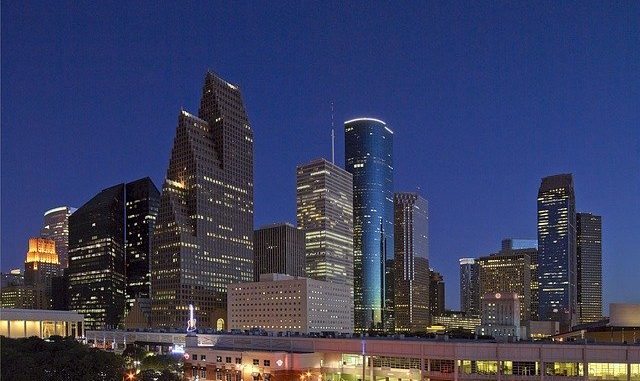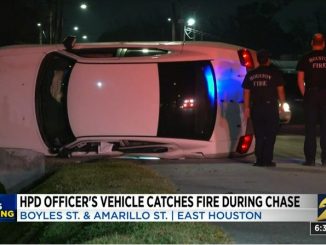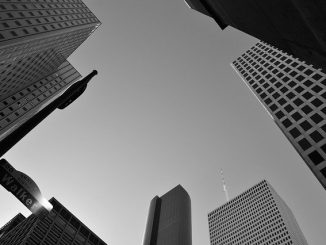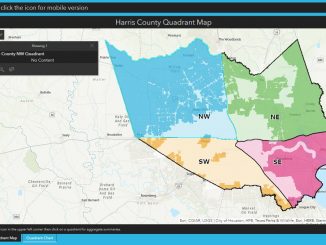
On 15 May 2015, the Houston Property Rights Association welcomed Kyle Workman, President of Texas Against High Speed Rail, to speak at its weekly group luncheon. Mr. Workman introduced himself, as one can read from his biography at the Texans Against High Speed Rail site, as a construction consultant who is volunteering his time to help lead the fight against the proposed high speed rail line between Houston and Dallas.
As is usual with HPRA lunches, there was quite a bit of yakking and fat chewing over various topics before Mr. Workman finally took the floor to make his presentation. As such, he had to make it in a bit of hurry, as he had another appointment right after the luncheon. Nonetheless, Mr. Workman packed quite a punch with the limited time he had.
Workman started off by giving a talk, before showing the group a film his group has put together. He described the Obama regime asking for $10 billion from the Nancy Pelosi / Harry Reid ruled Congress back in 2009 for a high speed rail network. That Congress approved the funding, but practically nothing went towards actual construction for various reasons. However, the appropriation attracted the attention of the Japanese, who, having spent 50 years of building (and propping up via tax support) the Shinkansen rail network, saw an opportunity to capture monies by building high speed trains in America.
So how is this high speed bull**** supposed to be funded?
One of the biggest issues that has been bothering me about this high speed bull**** project is, how is this project supposed to be funded? The folks at Texas Central Railway, led by former state representative and Harris County Judge Robert Eckels, have insisted over and over and over again that there will be no tax money needed to construct this project.
“That’s preposterous!” I keep saying to myself. There’s no way a 250-mile rail line can be built without massive taxpayer money. Nobody is going to loan a private actor the untold billions of dollars for such a project without hope of recouping their investment, and I sorely doubt that this project would qualify as a project that would even come close.
Mr. Workman, however, cleared the air and opened our eyes as to how the Japanese would be able to recoup at least some of their money. You see, it has been long established (since the 19th century) that railroads have the grant of eminent domain power for purposes of acquiring land. Hence, Mr. Workman enlightened us, what the plan will be is for Texas Central Railway (or the Japanese) to seize, via condemnation, a 250-mile long, broad swath of land reaching from Dallas to Houston, and Presto! — that land, gentle readers, now in the hands of the Japanese, becomes the equity by which the Japanese would be willing to finance such a massive project. It’s much the same way by which a bank or mortgage company becomes willing to lend you the money to buy your dream home. The finance company loans you the money, and if you for some reason are not willing or able to pay the bank or mortgage holder back, then the bank simply instigates legal proceedings to kick you out of the house and take it from you. The same idea goes for how the Japanese would finance the project.
How would this project affect Texans in urban and rural areas?
Well, differently of course! Mr. Workman described what this project would mean for Texans in rural areas. First, the project envisions construction of a tall fence on either side of the path of the rail line in order to prohibit anything from getting into the path of the oncoming trains. You certainly don’t want a herd of cattle wandering onto the path of a rail line like this, do you? Not a bad idea from a safety perspective, huh?
Well, try imagining for a moment being a rural Texas rancher or farmer, and what building such a fence would mean to your property. Without even discussing any issues of noise, train elevation, or route paths, building a fence on either side of the pathway of this rail line would cut your property in half. Rural landowners have long become accustomed to having to deal with electric utilities and oil and gas companies wanting to run power lines or pipelines through their property. However, Mr. Workman told us that the big difference between these two situations and a high speed rail line is that most rural landowners can live with easements they give up for power companies or oil companies, because their livestock can walk below the power lines, and the pipelines are usually buried below ground. They can still use their tractors to till soil, they can still pick up hay, and overhead power lines and pipelines are usually not too much of an obstacle. In contrast, cutting property in half would turn a landowner’s life upside down.
As for city slickers such as ourselves, it was clear to me that Mr. Workman has been following the news and the internet chatter in Houston over the high speed rail issue. He correctly told us that it appeared to him that many Inner Loopsters in Houston were falling all over themselves with excitement over the project. However, when the prospect reared its head that their neighborhood might be in the cross hairs of the rail line’s path, they suddenly became NIMBYs — they still want the project, but want the rail line to run through other people’s neighborhoods and for rail terminals to be located outside their area of town.
Mr. Workman commented that it seemed to him that some of the loudest support for high speed bull**** rail came from environmentalist types, who seemed to think that if this project took only one car off the road, then it was entirely justified. That statement was scary to contemplate.
The HSR route
As Mr. Workman continued his presentation, one of the points he brought up was that the projected route has not been settled, which is not what we may have been hearing in the media. Any proposed high speed rail route will need to be mostly straight. You can’t have a train that promoters are hoping will travel 200+ miles per hour going up and down a bunch of hills, or making many sharp turns. One of the routes that one might think would be a natural for a rail route would be right along the existing I-45 Interstate. However, the interstates were never even studied for traffic going over 140 miles per hour, much less 200 miles per hour. Moreover, eventually you do run into existing traffic, as you do if you run along a freight rail corridor. Recently, there was noise that a utility route had been chosen as the route, but Mr. Workman repeatedly stressed that no route has in fact yet been chosen.
See the Texans Against High Speed Rail’s webpage for proposed route maps.
The market for travel and project economics
As for the economics of the project, Workman told HPRA that the current market for travel between Houston and the Dallas / Fort Worth metroplex consists of some 18 million person trips per year by motor vehicle, with another 1.5 million annual trips being taken by Southwest Airlines between Love Field in Dallas and Hobby Airport in Houston. This works out to some 50,000 people per day traveling at least some stretch of the corridor by motor vehicle (albeit not necessarily the entire distance), while trips by air average some 4,100 passengers per day.
The promoters of the project have been telling the media that the market for this project is there because there are supposedly 50,000 super commuters per week who travel between Houston and Dallas and would be potential users of this rail line.
So, what would be my estimate of the actual travel market for high speed bull**** rail? Well, the recent tragic disaster that occurred in Philadelphia where an Amtrak trail derailed, killing eight people, led me to do some investigation of the Amtrak Acela route. The Acela Express, which runs between Boston in its north end, and Washington D.C. in its southern terminus, has 14 stops along the route. Boston has 4.7 million in its metropolitan area, while the greater Philadelphia area has some 6 million residents. Let’s not forget that the New York City metropolitan area is home to some 16-20 million residents, and that thanks to the gargantuan federal government, the Washington D.C. area is now home to some 5.8 million. In short, the Acela Express route has stops along a corridor where some 35 million Americans (1 in 10 Americans) live. The northeastern corridor is about three times as populous as the Dallas/Fort Worth to Houston corridor.
So, what has the Acela Express route achieved in terms of ridership? The Wikipedia page says that the Acela attracted some 3.3 million riders in 2013, or roughly 9,000 riders per day. And, the Acela has been in operation now for 15 years, and still needs taxpayer help to get by.
Much of the traffic between Dallas and Houston is no doubt freight truck traffic, commuter bus traffic, or families or friends traveling in vehicles. A family of four is not going to take this train, as Texas Central Railway has continuously told the public that they intend to price rail seat tickets at roughly the same price as a Southwest airline ticket. A quick check on the Southwest Airlines website, plugging in a same day return, round trip ticket between Houston and Dallas, with a ticket purchase one week in advance, shows that the price of a ticket would be $178. Meanwhile, you can make the 4 1/2 hour, 500 mile round trip drive between the two cities in a car at 16 – 25 miles per gallon using 20-30 gallons of gas, at a cost of $50 – $75. Then there’s the issue that if you don’t take a car to make your trip, you’ll likely have to rent one once you reach the city on the other side of the corridor.
Taking a SWAG, based upon the performance of the Acela Express, I’m suspecting that perhaps 3,000 – 4,000 people per day might be willing to pay $150 – $200 take a round trip train between Houston and Dallas, in addition to having to go through the trouble of renting a car once they get to the destination city. In effect, the target demographic for this scheme would mainly be CEOs and business executives, as well as high dollar lawyers who might be able to squeeze in an hour of client work while on the train. A few car-despising environmentalists, urban planners, rail fans, or an occasional politician might take the train too.
As for the cost of the project, Houston’s METRO recently opened two new rail lines, which cost $150 million or more per mile to construct. Assuming that the cost of constructing a rail line through mostly rural areas would be 30-50 percent lower, one is looking at $80 – $100 million-per-mile construction costs, which would put the 250-mile-long project at $20 – $25 billion. It’s quite conceivable that the costs could go much higher. Randal O’Toole has posted that the high speed rail line between Los Angeles and San Francisco, a 400 mile long trip, would cost $68 billion.
As for operational costs, that is a wide-open subject. One possible clue as to operational costs would be to look at METRO’s costs for operating the Main Street rail line. The original rail line was 7.5 miles in length (15 directional miles), and cost some $14 million per year to operate – a little under $1 million per directional mile. If that were to hold for this high speed rail line between Houston and Dallas, operational expenses would run some $500 million per year. Assuming my 3,000 – 4,000 passenger per day SWAG is accurate, we’re looking at a rail project which at $175 per round trip ticket would bring in some $200 – $250 million in revenues. Project promoters might likely be able to squeeze in some nominal advertising and vendor revenue from stations located along the route; however, it is highly likely that this project would need several hundred million dollars per year in taxpayer handouts in order to keep operating. The Texas Legislature, under such a scenario, would have to resort to perhaps raising the statewide gasoline tax by a few cents per gallon to bridge an annual operational funding gap, and would also likely have to act to impose a statutory limitation of liability damage claims against the rail train operator in the event of a major accident or disaster.
The current politics of this project
As I write this, the 84th Texas Legislature is rapidly winding down. Mr. Workman told HPRA that Texas Central Railway is spending $1 million per month now to push this project forward. He said that right now, project promoters have 14 lobbyists working the current legislature, while Texans Against High Speed Rail has 3 lobbyists opposing them. Meanwhile, Texans Against High Speed Rail has gotten commissioners from every single rural county through which the proposed high speed rail line is to run to adopt a resolution opposing the construction of the project. The overall picture that emerges is that this is a battle that pits city slickers against rural folks. As of right now, it looks as if there won’t be any taxpayer handouts being given towards this project. And yet, it’s just getting started. The political battle in the halls of power continues.
Final thoughts
There isn’t much more to say after writing a 2,500 word diatribe about this project. The overall question that is being asked will be, “is all this worth a few thousand high-income riders per day traveling between Houston and the Dallas / Fort Worth metroplex?” Not to me it isn’t. As far as I know, only one high speed rail line has ever paid its way in the world, and that was the original Shinkansen line between Tokyo and Osaka. Every other line in the world has needed propping up, and I’ve long since gotten tired of paying for other people’s daydreams.
Texas Central Railway has also tried justifying the project, contending that the commute between Houston and Dallas will increase by two hours in the next 20 years to 6 1/2 hours. Really? The worst trip I’ve ever taken between Houston and Dallas was when I made the drive the Sunday after Thanksgiving for a work-related trip. Despite having to slow down for no fewer than ten motor vehicle traffic accidents (likely mostly drunk drivers who had skidded off the road), and making the trip at the end of a major holiday, I still managed to make the trip in 5 1/2 hours.
Mr. Workman opined that high speed rail is not the future — Uber and self driving vehicles are, and having heard what he had to say, I agree with him. High speed rail really is high speed bull****.




Mr Meyer,
I know not where you live, but I assume in urban Houston. You are one of the first and only writer who completely understands HSR. I want to personally thank you for ‘splaining it to the ones who love the novelty idea. I, on the other hand, am a rural land owner in the crosshairs of TCR’s proposed train. I want permission to share your figures; heck, your whole article.
May God bless your intelligent mind!
Rhonda Page Jordan
PS look up my story on TexansAgainstHugh-SpeedRail on FB ‘Families Under the Rail’
His pants must be too tight
I am constantly amazed by those who oppose both High Speed Rail (HSR) and rail mass transit, especially by those who do not offer more sensible or viable alternatives or those who assume the mantle as “experts”. While the state cites a $4 billion annual shortfall in funding transportation infrastructure needs on one hand, the legislature on the other hand proposes billions of dollars in tax cuts. In the meantime, out of the 100,000 new Texas residents added each year, population in the Ft. Worth-Dallas-Houston metropolitan areas continue to grow at one of the fastest rates in the US. Traffic congestion is getting worse with only patchwork solutions that provide temporary and spot fixes.
While Rome continues to burn, our State and local government leaders and vocalists who have an axe to grind, unlike much of the rest of the world, stubbornly oppose rail solutions that can help mitigate our mobility woes. The current Republican administration is so poisoned against rail that it even has a stated anti-rail position in its official party platform (page 30).
Excluding contentious right-of-way issues by concerned property owners (some of which may be justifiable), there ARE compelling merits to build a HSR system linking Houston – Dallas – Fort Worth. Mr. Meyer himself even cites some of the reasons why lots of people would use the train – and, correctly, why families would not. Many traffic forecasts for this corridor paint a bleak picture if nothing is done to increase transportation capacity. The history of pouring more concrete using solely taxpayer dollars strongly suggests that this may no longer be the most economic solution, especially when a private company wants to come in and drop$10 billion plus to handle a sizeable amount of traffic between the two cities. Repeated studies of HSR show that HSR easily and fully pays for its full operating and maintenance costs. So, if Texas Central goes bankrupt, it is the investors that lose and there is no doubt that another enterprise will come along and pick up the pieces at a bargain price will greater assurance that it can make money. No taxpayer subsidy or dollars are involved and the public is still rewarded – both users of HSR and highway drivers that see fewer cars on the road. I have done my own independent study of Houston – Dallas HSR and would be pleased to share a copy of a 13 page summary of this study. I may be contacted at [email protected].
HSR, if done right, can be a solution that all but transportation experts, a few elected government officials, and many weary motorists seem to miss. Specifically, a public-private partnership with Texas Central’s proposed HSR could be a goldmine solution. By done right, I am referring to routing HSR along the I-45 corridor. This avoids much of the clamor against taking private land and, at the same time, offers the potential of adding commuter rail. It could be a win-win solution. Even Texas Central stated that it would be amenable to such a partnership if it enhances their business plan. There are many successful public / private commuter rail partnerships in the US involving freight, passenger (Amtrak), commuter rail and public agencies. There is no reason to believe a similar relationship couldn’t be developed with Texas Central. Contrary to Mr. Meyer’s unsubstantiated assertions, Amtrak’s anemic Acela is very successful and faces a shortage of equipment to handle the demand. (I know from first hand experience in addition to what I read.) Acela’s revenues exceed its full operating and maintenance costs and actually subsidizes other Amtrak operations.
Neither Houston, Harris County, Montgomery County nor local communities have made significant efforts to study the inclusion of commuter rail with HSR (similar to what is done in Amtrak’s Northeast Corridor), perhaps passing up a very short opportunity to do so at a fraction of the cost of a standalone commuter rail system. If positive action is not taken to forge a public / private partnership with Texas Central, the opportunity to route the HSR line in a major commuter corridor could be forever lost. The two routes selected for environmental assessment by Texas Central currently exclude the I-45 corridor and neither proposed route offers as big a potential for commuter rail. Commuter rail could even be a feeder to HSR and help justify the higher capital cost of this route option and perhaps a downtown station as well.
South of The Woodlands, the 2006 Houston Urban Traffic Map showed over 200,000 vehicles per day on I-45, each way. (Again, this study is also 9 years old!) More current information published in the Houston Chronicle now put this over 250,000 vehicles per day. The largest portion, by far, is commuter traffic. Additionally, The Woodlands Park and Ride bus service to and from Houston handled 734,000 riders in 2013 and is projected to handle 826,000 riders by 2018 – an indication of the desirability of commuter services.
What elected officials are potentially throwing away is a $10 billion plus gift (private investment) in transportation infrastructure and a potential 75-80 percent matching federal capital grant for mass transit investment, the combined total of which could easily approach or exceed $15 billion. Compare this to the $2.5 billion highway budget that the Texas Senate proposes for the current fiscal year.
Houston is, by far, the largest metropolitan area in all of North America that does not have any form of heavy rail or commuter rail mass transit, Again, for emphasis, State and local governments now have a unique, short term opportunity to piggyback commuter rail on top of a huge private capital investment.
I have repeatedly urged elected officials to re-examine their position on HSR and rail mass transit. There are solutions to the concerns noted by many. Let’s not pass up $10 billion in private transportation infrastructure investment; the creation of work for several thousand construction workers; the creation of 400 plus permanent full time jobs to run the railroad; taking hundreds of thousands (or more) cars off I-45 between Houston and Dallas; reducing injuries, deaths, and property damage that go with taking cars off the road; reducing air pollution, and the opportunity to introduce commuter rail between Houston, The Woodlands, Conroe, and perhaps even Bush airport (IAH) at a relatively low incremental cost (resulting in saving even more lives and keeping more thousands of automobiles off over-saturated highways). By re-thinking opinions on HSR and rail mass transit we also can avoid or at least defer the futility of spending billions of dollars for more concrete.
Opposition by biased and prejudiced “experts” like Mr. Meyers do not help achieve the best solutions to solving growing transportation issues. As a (retired) professional consultant in HSR and commuter rail I find Mr. Meyer’s focused diatribe a disservice to promoting viable solutions to growing transportation capacity issues between Houston and Dallas